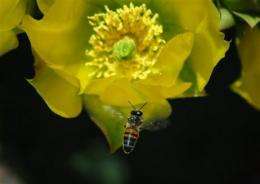A bee descends on a blooming cactus flower Tuesday morning, May 19, 2009, at Cielo Grande Recreation Area in Roswell, N.M. Federal officials say the decline of honeybee colonies may have slowed slightly but warn that mysterious ailments are still affecting the insects. U.S. Department of Agriculture researchers found that honeybee colonies declined by 29 percent between September 2008 and early April. (AP Photo/Roswell Daily Record Mark Wilson)
(AP) -- The decline of honeybee colonies has slowed slightly since last fall, but a mysterious combination of ailments is still decimating the insect's population, federal researchers say.
U.S. Department of Agriculture researchers found that honeybee colonies declined by 29 percent between September 2008 and early April. That's an improvement over the last two years, when researchers found that 32 percent and 36 percent of all beekeepers surveyed lost hives.
Domestic honeybee stocks have been waning since 2004 because of a puzzling illness scientists called colony collapse disorder, which causes adult bees to inexplicably forsake their broods. Bees now appear also to be suffering from other ailments.
Honeybees help pollinate many fruits and vegetables, including blueberries, tomatoes, apples and almonds.
The disorder has killed off the weakest colonies in recent years, and now pesticide drift and old foes such as the parasitic varroa mite are more likely threatening those that survived, said Jerry Hayes, a former president of the Apiary Inspectors of America, whose members helped carry out the survey.
"Whether it's CCD or pesticides, fungicides or chemicals affecting how the queens respond, I don't know that beekeepers care," said Hayes, chief of the apiary sector of the Florida Department of Agriculture. "The ones who I talk to are just beside themselves. If you are a small business person how many years of 30 percent losses can you take?"
Regardless of the cause, bees are still dying at rates that could put some keepers out of business, said Jeff Pettis, the USDA's top bee scientist.
The survey released Tuesday included 787 beekeepers who account for 20 percent of the country's approximately 2.3 million commercially managed bee hives. The data - collected through a spring telephone survey in which researchers polled keepers about how many of their hives survived the fall and winter, when queens go dormant - is being prepared for submission to a journal.
©2009 The Associated Press. All rights reserved. This material may not be published, broadcast, rewritten or redistributed.





















